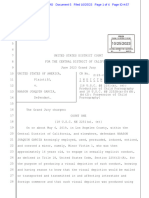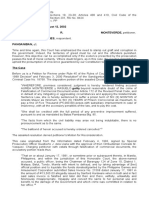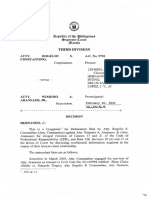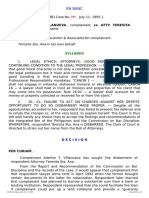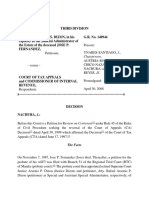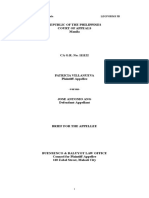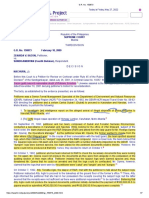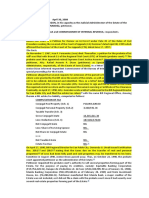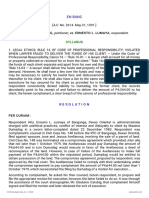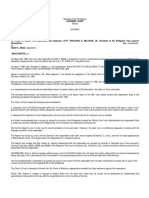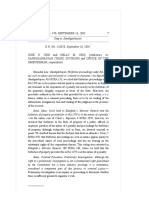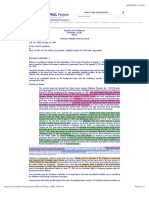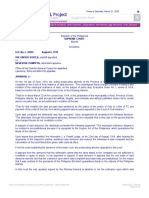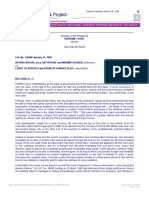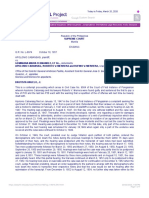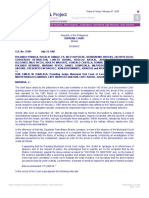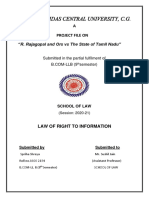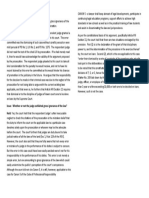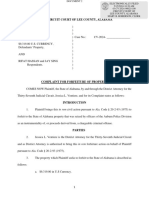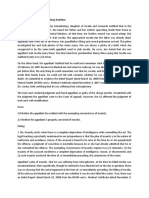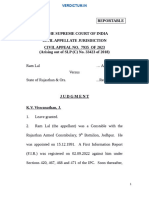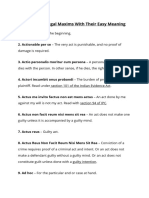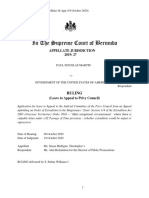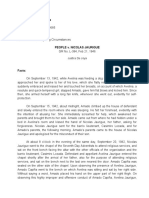MONTEVERDE v. PEople
MONTEVERDE v. PEople
Uploaded by
Kristela AdraincemCopyright:
Available Formats
MONTEVERDE v. PEople
MONTEVERDE v. PEople
Uploaded by
Kristela AdraincemOriginal Title
Copyright
Available Formats
Share this document
Did you find this document useful?
Is this content inappropriate?
Copyright:
Available Formats
MONTEVERDE v. PEople
MONTEVERDE v. PEople
Uploaded by
Kristela AdraincemCopyright:
Available Formats
Today is Sunday, January 19, 2020
Custom Search
Constitution Statutes Executive Issuances Judicial Issuances Other Issuances Jurisprudence International Legal Resources AUSL Exclusive
THIRD DIVISION
G.R. No. 139610 August 12, 2002
AUREA R. MONTEVERDE, petitioner,
vs.
PEOPLE OF THE PHILIPPINES, respondent.
PANGANIBAN, J.:
Time and time again, this Court has emphasized the need to stamp out graft and corruption in the government.
Indeed, the tentacles of greed must be cut and the offenders punished. However, this objective can be
accomplished only if the evidence presented by the prosecution passes the test of moral certainty. Where doubt
lingers, as in this case, the Court is mandated to uphold the presumption of innocence guaranteed by our
Constitution to the accused.
The Case
Before us is a Petition for Review under Rule 45 of the Rules of Court, assailing the April 29, 1999 Decision1 and
February 3, 2000 Resolution2 of the Sandiganbayan (Second Division) in Criminal Case No. 18768. The dispositive
portion of the assailed Decision reads as follows:
"WHEREFORE, premises considered, judgment is hereby rendered finding accused AUREA MONTEVERDE
y RASUELO guilty beyond reasonable doubt of the crime of Falsification of Commercial Document under
Article 172 of the Revised Penal Code, and in default of any mitigating or aggravating circumstances and
applying the Indeterminate Sentence Law, she is hereby sentenced to suffer a prison term of SIX (6)
MONTHS of Arresto Mayor as minimum, to SIX (6) YEARS of Prision Correccional as maximum, to pay a fine
of Five Thousand (P5,000.00) pesos with subsidiary imprisonment in case of insolvency, with all the
accessory penalties of the law, and to pay the cost.
"She shall be credited with the full period of any preventive imprisonment suffered, pursuant to and as
mandated by Batas Pambansa Blg. 85.
"The facts from which the civil liability may arise not being indubitable, there is no pronouncement as to the
same.
"The bailbond of herein accused is hereby ordered cancelled."3
The assailed resolution denied petitioner’s Motion for Reconsideration.
This case originated from the Information dated February 4, 1993, signed by Special Prosecution Officer Gualberto
https://lawphil.net/judjuris/juri2002/aug2002/gr_139610_2002.html 19/01/2020, 11=28 PM
Page 1 of 10
J. dela Llana with the approval of then Ombudsman Conrado M. Vasquez. Charging petitioner with estafa through
falsification of commercial documents, the accusatory portion reads thus:
"That on or about January 17, 1991, or sometime prior or subsequent thereto, in Manila, Philippines, and
within the jurisdiction of this Honorable Court, the above-named accused, a public officer, being the Chairman
of Barangay 124 of Zone 10, District 1, Malaya, Balut, Tondo, Manila with intent to defraud, and by taking
advantage of [her] official position and to liquidate the funds donated/granted by the Philippine Games and
Amusement Corporation submitted Sales Invoice No. 21568 dated January 17, 1991 in the amount of
P13,565.00 allegedly issued by Sanford Hardware when in truth and in fact said sales invoice is falsified and
later did then and there, willfully, unlawfully and feloniously misappropriate, misapply and convert the same to
her personal use and benefit, to the damage of the Government and which crime was committed in relation to
her office."4
During her arraignment on April 5, 1993, petitioner, assisted by her counsel de parte,5 pleaded not guilty.6 After trial
on the merits, the Sandiganbayan acquitted petitioner of the crime of estafa, but convicted her of falsification of a
commercial document under Article 172 of the Revised Penal Code.
The Facts
Version of the Prosecution
The prosecution’s version of the facts is curtly summarized by the Office of the Special Prosecutor (OSP) as follows:
"Petitioner Aurea A. Monteverde was from 1991 to 1993 the Barangay Chairman of Barangay 124 of Zone 10,
District 1, Malaya, Balut, Tondo, Manila. In that capacity, she received the amount of P44,800.00 from the
Philippine Amusement and Gaming Corporation (PAGCOR). The amount was spent for lighting, cleanliness
and beautification programs of the Barangay. To liquidate the amount, she submitted a financial statement
(Exhibits ‘1 to 1-A-3’) with copies of sales invoices/receipts to PAGCOR.
"Sometime in August 1991, Antonio R. Araza, Jose Salvatierra, Santos L. Lopez, and Narciso Cruz, residents
of Brgy. 124, charged Petitioner and Bella Evangelista, then Barangay Treasurer, with Malversation of the
following funds: 1.) P82,500.00 from [the] Barangay General Fund; 2.) P44,800.00 from the PAGCOR; and 3.)
P600.00 allowance of Kagawad Lito Galinda for the period July 16, to December 1990. The complaints were
docketed as OMB-0-91-12694 and OMB-0-92-0643 (Exhs. A, B and C)."7
Version of the Defense
The foregoing account is reiterated by the Office of the Solicitor General (OSG) in its Memorandum.8 The petitioner
did not submit her own Memorandum, but merely adopted the position of the OSG which recommended her
acquittal.
Version of the Sandiganbayan
The foregoing narration does not adequately explain the evidence. In fairness to the Sandiganbayan ("SBN"
hereafter) which is being faulted with reversible errors by petitioner and the OSG, we deem it prudent to quote the
facts and the evidence it relied upon in its assailed Decision, as follows:
"EVIDENCE FOR THE PROSECUTION
In its bid to establish the guilt of the accused beyond reasonable doubt, the People presented the following
documentary evidence:
1. Exhibit A which is a letter complaint addressed to the Ombudsman dated September 2, 1991 signed
by Santos Lopez, Narciso Cruz, Antonio Araza and Jose Salvatierra;
2. Exhibit B which is a Joint-Affidavit of the said four (4) complainants subscribed and sworn to before a
Notary Public on September 8, 1991;
3. Exhibit C which is a letter dated June 13, 1991 signed by complainants Jose Salvatierra and Antonio
https://lawphil.net/judjuris/juri2002/aug2002/gr_139610_2002.html 19/01/2020, 11=28 PM
Page 2 of 10
Araza addressed to Mr. Manuel de la Fuente of the Chief Barangay Bureau, City of Manila;
4. Exhibit D which is the cover of the Booklet of Sales invoice[s]/Receipts of Sanford Hardware.
5. Exhibit D-1 which is the duplicate original copy of Sales Invoice No. 21568 dated July 20, 1981
listing only three (3) items;
6. Exhibit D-1-A which is a genuine machine copy of Exhibit D-1;
7. Exhibit E which is a machine copy of an official receipt with Aurea Monteverde appearing as buyer
and listing eleven items as articles purchased;
8. Exhibit E-1 which is a certification of Luz Co, Manager of Sanford Hardware stating that Exhibit E is
not a genuine reproduction of the duplicate original;
9. Exhibit F (offered lately) is a xerox copy of Invoice No. 21568 dated January 17, 1991;
10. Exhibit G is a machine copy of an undated letter signed by Bella Evangelista authorizing Antonio
Araza to verify the authenticity of Invoice No. 21568 dated January 17, 1991 in the sum of P13,565.00
as well as witnesses Luz Co y Tan and Antonio Araza y Reposo.
"LUZ CO y TAN declared that she is the manager of Sanford Hardware since 1976, that Exhibit D-1 which is
[a] duplicate copy of Invoice No. 21568 dated July 2, 1981 where the amount of purchase is only P157.00 is
the invoice used by her firm in the conduct of its business; that Exhibit E was not her receipt and that she
executed a certification to that effect (Exhibit E-1) when required by a male person; that she does not know
the entries appearing in Exhibit E but the entries in Exhibit D-1 are of her business; that Sanford Hardware is
owned by [her] sister-in-law Delia Co; that there are three copies of the sales invoice her business is issuing,
and the third copy or last copy is the one left in the store, and that the one who approached her and asked
about Exhibit E is one Narciso Cruz and when she answered that she did not issue Exhibit E she was
requested to execute an affidavit; that she does not know accused Aurea Monteverde and that she had no
delivery of hardware materials to the Barangay on January 17, 1991 (TSN May 14, 1993).
"It was the testimony of ANTONIO ARAZA that he is a resident of 2256 Malaya St., Balut, Tondo, Manila and
that he secured a copy of Exhibits E and F from the Barangay Treasurer; that he brought the same to the
owner of the Sanford Hardware for verification; that Luz Co to whom he talked x x x in said store manifested
that said Exhibits E and F are not issued by the firm; and for which he requested Luz Co to issue a
certification (Exhibit E-1); that after realizing that the receipts used by the accused are falsified receipts, he
signed letter complaints and [a] Joint-Affidavit together with Santos Lopez, Narciso Cruz and Jose Salvatierra,
and charged the accused before the Ombudsman; that the money involved in this case are barangay funds
because it was donated by the PAGCOR to the Barangay and he was able to secure a copy from the
PAGCOR evidencing that it was donated to the Barangay but the copy was submitted to the Ombudsman;
that the Barangay Treasurer lent to him the receipts with the advice to verify it from the proprietor of [the]
Hardware and she even gave a letter of authorization to him (Exhibit G); that the P13,565.00 appearing in
Exhibits E and F was not used to buy electrical materials or lightings, and the bulbs in the Meralco post were
donated by Councilor Rene Jose (TSN March 18, 1994).
"EVIDENCE FOR THE ACCUSED
"The defense presented eighty-one (81) Exhibits with Exhibits 35 to 80 dealing with certificates of
commendation in favor of the accused during her stint as Barangay Chairman from 1991 to 1993 and even
prior to her being a Barangay Chairman. Exhibits 1 with its submarkings (Exhibits 1-A to Exhibits 1-A-3) is a
letter of the accused addressed to Alice LI Reyes of the PAGCOR with attachment she captioned Financial
Statement; Exhibits 2 to 15 are Sales Invoices/Receipts from different hardware stores and individuals while
Exhibits 16 and 17 are pictures depicting a basketball court portion thereof being sub-marked, and Exhibits 18
to 32 are fifteen (15) pictures depicting different alleys at Barangay 124. Exhibit 33 is a turn-over
certificate/record of the Barangay properties signed by the incoming Barangay Chairman with the third page
submarked as Exhibits 33-A to 33-b-2; and Exhibit 34 is the counter-affidavit of the accused sworn to before a
Notary Public on September 5, 1991. Exhibit 81 is a Joint-Affidavit of Alfonso Cua Jr. and Joel Magbanua.
https://lawphil.net/judjuris/juri2002/aug2002/gr_139610_2002.html 19/01/2020, 11=28 PM
Page 3 of 10
"Aside from her, the accused presented ALFONSO CUA, JR. whose testimony is as follows: that he knows
the accused to be the Chairman of Barangay 124 from 1991 up to 1992 while he was a Barangay Tanod in
the said Barangay; that one project of the accused was the installation of lights or lighting the streets and
playgrounds in the Barangay; that in January 1991 materials were delivered to the house of the Barangay
Chairman (accused) and around three (3) days thereafter, he helped in the installation of the electrical
materials consisting of electrical wirings, electrical tapes, bulbs, lamps and lamp covers, and it took them (he
and the husband of the accused) about three Sundays in doing so; that he executed a Joint-Affidavit together
with one Joel Magbanua in connection with the incident (Exhibit 81) (TSN April 2, 1997).
"Testifying in her behalf accused took the witness stand and declared:
‘That she was the Barangay Chairman in Brgy. 124 since 1989 to 1994; that in January 1991 she received
donation or cash money in the amount of P44,800.00 from PAGCOR which she used in Barangay projects
like lighting, and cleanliness and beautification; that she reported the matter to PAGCOR and submitted [a]
financial statement (Exhibits 1 to 1-A, 1-A-1); that when she purchased electrical and hardware items from
Sanford Hardware she was issued a receipt (Exhibit 9) and considering Exhibit D-1 and D-1-A, it would
appear that Sanford Hardware issued two (2) receipts; she denied the charge of Estafa thru Falsification of
Commercial Documents, and claimed that with the meager amount involved, she is not going to sacrifice her
good name and reputation; she then identified x x x several awards she received (Exhibits 35 to 79); that she
was the one who personally purchased the items in Exhibit F, and she actually paid the same in cash for
which she was issued Exhibit 9 (Exhibit F and 9 contain the same items); that the receipt was issued in her
name and the money was in her possession that was why it was she and not the Barangay Treasurer who
personally made the purchase; that the PAGCOR check was issued in her name and was directly given to her
and so she was the one who encashed the check accompanied by one of the councilors but she did not turn
over the cash to the treasurer; that even after she came to know of the existence of Exhibit E, she did not go
to Sanford Hardware to inquire about the said document; that the original of the said exhibit was given to her
but she submitted it to PAGCOR. (TSN September 3, November 5, 1996 and April 1, 1997).’"9
Ruling of the Sandiganbayan
The assailed Decision noted that petitioner was supposed to have been charged with the complex crime of estafa
through falsification of a commercial document. However, there was no clear allegation in the Information that the
falsification was a necessary means to commit the estafa.10 Nevertheless, going along "with the supposition" that a
complex crime had been charged, the SBN held:
"Despite the ambiguity and disquietude, however, the court is constrained to go with the supposition that what
has been charged is that of a complex crime, otherwise the logical consequence is that the accused has been
indicted with two crimes - that of Estafa and that of Falsification of Commercial Document which is not
beneficial to her."11
The anti-graft court acquitted petitioner of estafa, because there was no evidence that funds had been
misappropriated or converted.12 Neither was there proof that petitioner had been required to account for the money
received.13 Without these proofs, no conviction for estafa was possible.14
However, the court a quo convicted her for allegedly falsifying the document she had submitted to show that the
P13,565 donated by PAGCOR was used and spent for lighting materials for her barangay. According to the SBN,
the falsification became very clear when the document was compared with another one purporting to be a duplicate
original presented by the prosecution.15 While the prosecution did not present any proof evidencing that it was
petitioner who had caused the falsification, the SBN relied on the presumption that in the absence of a satisfactory
explanation, a person who is found in possession of a forged document, and who uses it, is the forger.16
Nevertheless, petitioner was not convicted of falsification as defined by Article 171 of the Revised Penal Code,
because there was no proof that she had taken advantage of her position in committing the crime.17 Instead, she
was convicted of falsification under Article 172.18
Hence, this Petition.19
https://lawphil.net/judjuris/juri2002/aug2002/gr_139610_2002.html 19/01/2020, 11=28 PM
Page 4 of 10
Issues
The OSG’s Memorandum which recommended acquittal, and which petitioner adopted, raised the following issues:
"Whether the Sandiganbayan erred in:
[1.] finding petitioner guilty of falsification despite its finding that no estafa was committed[;]
[2.] holding that Exhibit 9, a sales invoice, was a commercial/public document[; and]
[3.] applying the presumption that petitioner was the author of falsification in the absence of any proof that she
benefited from it."20
This Court’s Ruling
The Petition is meritorious.
First Issue:
Nature of Complex Crimes
Appellant was purportedly charged with the complex crime of estafa through falsification of a commercial document.
However, even if the SBN itself doubted whether the Information had properly charged a complex crime, it was, as
quoted earlier, "constrained to go along with the supposition that what has been charged is that of a complex crime,
otherwise the logical consequence is that the accused has been indicted with two crimes -- that of Estafa and that of
Falsification of Commercial Document which is not beneficial to her."21
We clarify. Under Article 48 of the Revised Penal Code,22 a complex crime refers to (1) the commission of at least
two grave or less grave felonies that must both (or all) be the result of a single act, or (2) one offense must be a
necessary means for committing the other (or others).23 Negatively put, there is no complex crime when (1) two or
more crimes are committed, but not by a single act; or (2) committing one crime is not a necessary means for
committing the other (or others).24
Using the above guidelines, the acts attributed to petitioner in the present case cannot constitute a complex crime.
Specifically, her alleged actions showing falsification of a public and/or a commercial document were not necessary
to commit estafa. Neither were the two crimes the result of a single act. The OSG correctly observed:
"x x x. The alleged falsification happened after the money was spent and to explain how it was expended.
Thus there is no complex crime since the falsification is not a necessary means for committing the estafa (as
charged) or malversation (as suggested by Sandiganbayan in its Order dated February 1, 2000). If at all, it
was intended to conceal the estafa or malversation."25
Well-known is the principle that an information "must charge only one offense, except when the law prescribes a
single punishment for various offenses."26 When more than one offense is charged, the accused may move to
quash the information.27
In the present case, the accused should have objected to the Information on the ground that more than one offense
was charged therein. For her failure to move to quash the indictments, she is deemed to have waived her right to be
tried for only one crime.28 Furthermore, she did not object to the submission of evidence that tended to prove the
offenses charged in the Information -- estafa and falsification. Verily, when two or more offenses are charged in a
single complaint or information, but the accused fail to object to the defect before trial, the trial court may convict
them of as many offenses as are charged and proven, and impose on them the penalty for each offense, setting out
separately the findings of fact and law in each.29
On the basis of the foregoing, we reject the argument of petitioner that since she was acquitted of estafa, she could
no longer be convicted of falsification of a commercial document. Having, in effect, been charged with two distinct
crimes, acquittal in one will not necessarily lead to acquittal in the other. Each crime will be evaluated based on its
own merits, and conviction will depend on the proof of the elements of each particular offense.
https://lawphil.net/judjuris/juri2002/aug2002/gr_139610_2002.html 19/01/2020, 11=28 PM
Page 5 of 10
Let us assume that petitioner has correctly been charged with a complex crime, as the SBN supposed. Still,
acquittal from a component offense will not necessarily lead to an acquittal from the other (or others).
When a complex crime under Article 48 of the Revised Penal Code is charged, it is axiomatic that the prosecution
must allege in the information and prove during the trial all the elements of all the offenses constituting the complex
crime.
We stress that the failure of the prosecution to prove one of the component crimes and the acquittal arising
therefrom will not necessarily lead to a declaration of innocence for the other crimes. Settled is the rule that when a
complex crime is charged and the evidence fails to establish one of the component offenses, the defendant can be
convicted of the others, so long as they are proved.30
Second Issue:
Nature of Sales Invoice
The OSG agrees that the subject Sales Invoice is a public and/or a commercial document within the meaning of
"falsification" as defined under the Revised Penal Code.
Both the OSG and the OSP agree that a private document acquires the character of a public document when it
becomes part of an official record and is certified by a public officer duly authorized by law.31 The OSP aptly
explained this point as follows:
"x x x, [I]f the document is intended by law to be part of the public or official record, the preparation of which
being in accordance with the rules and regulations issued by the government, the falsification of that
document, although it was a private document at the time of its falsification, is regarded as falsification of
public or official document.
"Prosecution witness Luz Co testified that the duplicate original of Sales Invoice No. 21568 was submitted to
the Bureau of Internal Revenue (BIR). Thus this Sales Invoice is intended to be part of the public records and
the preparation thereof is required by BIR rules and regulations. Moreover, Sales Invoice No. 21568 formed
part of the official records of PAGCOR when it was submitted by petitioner as one of the supporting papers for
the liquidation of her accountability to PAGCOR."32
Neither can it be denied that the Sales Invoice is also a commercial document. Commercial documents or papers
are those used by merchants or businessmen to promote or facilitate trade or credit transactions.33 This Court has
previously characterized such documents in this wise:
"x x x. In most cases, these commercial forms [receipts, order slips and invoices] are not always fully
accomplished to contain all the necessary information describing the whole business transaction. The sales
clerks merely indicate a description and the price of each item sold without bothering to fill up all the available
spaces in the particular receipt or invoice, and without proper regard for any legal repercussion for such
neglect. Certainly, it would not hurt if businessmen and traders would strive to make the receipts and invoices
they issue complete, as far as practicable, in material particulars. These documents are not mere scraps of
paper bereft of probative value but vital pieces of evidence of commercial transactions. They are written
memorials of the details of the consummation of contracts."34 (Italics supplied)
Third Issue:
Proof of Guilt
The gut issue in this case is whether the prosecution was able to prove beyond reasonable doubt the guilt of
petitioner with regard to the crime of falsification. A determination of this question will necessarily require an
examination of the facts as presented before the Sandiganbayan.
As a rule, an appeal by certiorari under Rule 45 of the Rules of Court raises only questions of law.35 However, this
Court, in exceptional cases, has taken cognizance of questions of fact in order to resolve legal issues. This is
especially true in cases in which a palpable error or a grave misapprehension of facts was committed by the lower
court.36 Criminal cases elevated by public officials from the SBN deserve the same thorough treatment by this Court
as criminal cases brought up by ordinary citizens, simply because the constitutional presumption of innocence must
https://lawphil.net/judjuris/juri2002/aug2002/gr_139610_2002.html 19/01/2020, 11=28 PM
Page 6 of 10
be overcome by proof beyond reasonable doubt in both instances. Indeed, in a criminal case, a person’s life or
liberty is at stake.37
Petitioner asserts that the SBN erroneously applied the presumption that the possessor of a forged or falsified
document who uses it is the author of the forgery or falsification. The OSG concurs with her on this point. That is
why it recommended that she be acquitted.
We agree. To our mind, the prosecution’s evidence is not sufficient to convict. As correctly observed by the OSG,
the Decision of the SBN is based on the assumption that there was only one set of sales invoices issued by Sanford
Hardware. On such a premise, petitioner’s Exhibit 9 thus becomes obviously falsified when compared with
respondent’s Exhibit D-1. But on the premise that the two Exhibits are two different Sales Invoices, falsification
becomes doubtful. The OSG is correct in observing as follows:
"x x x. For petitioner or anybody acting on her behalf to falsify the customer’s copy of Sales Invoice No.
21568, she/he would have to erase or cover with correction fluid the spaces pertaining to the name of the
customer, date, quantity, unit, description of articles, unit price and amount, before the insertions could be
written. Neither the appealed decision nor the transcript of stenographic notes (TSN) point out various tell-tale
signs of falsification despite opportunity of the prosecution to see the original of Exh. 9. The only observation
the respondent Court mentioned was with respect to the date: ‘[t]he superimposition of January 17, 1991 is
too apparent to be disregarded, and the alteration of the date has affected both the veracity and the effects of
the said document.’ But the changing of the date was the easiest to accomplish. The more cumbersome, as
they affect wider space, would [have been] the name of the customer and the purchases. The total absence
of any hint or sign of alteration on these areas is revealing."38
The only logical explanation for the existence of both Exhibits 9 and D- 1 is that there are two extant documents.
Whether one is the original and the other is falsified depends on the proof. This the prosecution had to prove, but
unfortunately failed to. In all criminal prosecutions, without regard to the nature of the defense which the accused
may raise, the burden of proof establishing the guilt of the accused beyond reasonable doubt remains with the
prosecution.39 Further, it is the duty of the prosecution to prove each and every element of the crime charged in the
information.40 We repeat that, in this case, it failed to discharge this duty. We quote with approval the OSG’s
disquisition on these two documents as follows:
"A comparison between Exh. D-1 and Exh. 9 shows that there are two (2) sets of Sales Invoice No. 21568.
While the form is identical in most respects, there are three (3) telling differences: (1) the type set of the sales
invoice numbers are different, (2) the bottom left of Exh. D-1 indicates the name of the printing press while no
such information is indicated anywhere in Exh. 9, and (3) the bottom right of Exh. D-1 states the BIR permit
which does not appear in Exh. 9. Who could have printed Exh. 9 is anybody’s guess. It is possible that
petitioner or any person acting on her behalf had a printing company copy this particular Sanford Hardware
invoice so she could use it to liquidate the PAGCOR funds she received. However, it is equally possible that
Sanford Hardware had printed two (2) sets of the same receipts, one to reflect the real business transaction,
the other one - a sanitized version - for the consumption of the BIR people. Not one of these possibilities has
been actually proven, but neither was their improbability established."41 (Italics supplied)
Indeed, the OSG points out that there are material differences between Exhibits 9 and D-1. These include: 1) the
discrepancy in the "type set" or fonts used for the sales invoice numbers in the two Sales Invoices; 2) the presence
of the name of the printing press at the bottom left corner of Exhibit D-1 and its absence in Exhibit 9; and 3) the
presence of the BIR permit in Exhibit D-1 and its absence in Exhibit 9. It is possible that Exhibit 9 was printed by
petitioner or anyone acting on her behalf to facilitate the liquidation of funds. But it is equally possible, as the OSG
points out, that Sanford Hardware caused the printing of two sets of receipts to serve its own purposes. However,
none of these possibilities was either actually proven or definitely ruled out by the prosecution. At bottom, there is no
clear and convincing evidence to prove that Exhibit 9 was falsified.
The SBN relied on the settled rule that in the absence of a satisfactory explanation, one found in possession of --
and who used, took advantage of or profited from -- a forged or falsified document is the author of the falsification
and is therefore guilty of falsification.
To convict petitioner of falsification would mean that the prosecution was able to establish that Exhibit 9 was a
https://lawphil.net/judjuris/juri2002/aug2002/gr_139610_2002.html 19/01/2020, 11=28 PM
Page 7 of 10
falsified copy of an original document. But the rule itself shows that it cannot be applied to the present case,
because Exhibit 9 (Sales Invoice No 21568) was not established beyond reasonable doubt to have been forged or
falsified. At the very least, it may be a second document that may or may not have been printed by petitioner herself.
Respondent claims that the original document is Exhibit D-1 but, as adverted to earlier, Exhibit 9 was not
satisfactorily demonstrated to be a copy thereof. In other words, Exhibit 9 being different from Exhibit D-1, the
prosecution cannot be deemed to have presented an original document, of which Exhibit 9 is a falsified copy.
The question is: who made this second document marked Exhibit 9? Petitioner consistently maintains that Exhibit 9
was issued to her by Sanford Hardware when she purchased the items mentioned therein. On the other hand, the
manager of Sanford Hardware denies having issued such document. Indeed, it is a time-honored principle42 that
greater probative value is accorded to a positive than to a negative testimony. Furthermore, as correctly pointed out
by the OSG:
"x x x [Petitioner] denied the accusation and insisted that she would not sacrifice her name and reputation for
the meager amount involved. She submitted photographs that the lighting of alleys in Barangay 124 was
completed. There was positive testimony by Alfonso Cua, one of the persons who installed the articles listed
in Sales Invoice No. 21568. The prosecution failed to rebut these."43 (Citations omitted)
One final point. The SBN held that the "accused refused to present the original of Exhibit 9," and that it would have
been so "easy x x x to ask for a subpoena to direct x x x the PAGCOR to produce the original copy, and yet the
accused satisfied herself in presenting Exhibit 9 -- a mere xerox copy of the supposed document." But, as pointed
out by the OSG in its Memorandum,44 the original of Exhibit 9 was presented in court during the November 5, 1996
hearing after a subpoena duces tecum had been issued to PAGCOR, and Prosecutor Pimentel "confirmed that the x
x x xerox copies are faithful reproductions of the original."45
In all criminal cases, mere speculations cannot substitute for proof in establishing the guilt of the accused.46 Indeed,
suspicion no matter how strong must never sway judgment. Where there is reasonable doubt, the accused must be
acquitted even though their innocence may not have been established. The Constitution presumes a person
innocent until proven guilty by proof beyond reasonable doubt. When guilt is not proven with moral certainty, it has
been our policy of long standing that the presumption of innocence must be favored, and exoneration granted as a
matter of right.47
Although the evidence for the defense may be frail, criminal conviction must come, not from its weakness, but from
the strength of that for the prosecution.48
WHEREFORE, the Petition is GRANTED and the assailed Decision and Resolution SET ASIDE. Petitioner is
ACQUITTED on reasonable doubt. No pronouncement as to costs.
SO ORDERED.
Puno, and Carpio, JJ., concur.
Sandoval-Gutierrez, J., on leave.
Footnotes
1 Annex "A" of the Petition; rollo, pp. 20-37. Penned by Justice Edilberto G. Sandoval (Division chairman) with
the concurrence of Justices Godofredo L. Legaspi and Alfredo J. Gustilo (members).
2 Rollo, pp. 46-49; Justice Gregory S. Ong replaced Justice Gustilo.
3 Sandiganbayan Decision, pp. 16-17; rollo, pp. 35-36.
4 Records, p. 1.
5 Atty. Eduard C. Castañeda.
https://lawphil.net/judjuris/juri2002/aug2002/gr_139610_2002.html 19/01/2020, 11=28 PM
Page 8 of 10
6 Sandiganbayan Order dated April 5, 1993; records, p. 29.
7 OSP’s Memorandum, pp. 1-2; rollo, pp. 143-144.
8 OSG’s Memorandum, pp. 1-2; rollo, pp. 121-122.
9 Sandiganbayan Decision, pp. 3-7; rollo, pp. 22-26.
10 Ibid., pp. 8 & 27.
11 Id., pp. 9 & 28.
12 Id., pp. 11 & 30.
13 Ibid.
14 Ibid.
15 Id., pp. 12 & 31.
16 Id., pp. 15 & 34.
17 Id., pp. 16 & 35.
18 Ibid.
19 The case was deemed submitted for resolution on September 17, 2001, upon this Court’s receipt of
petitioner’s Manifestation signed by Atty. Vicente C. Angeles, adopting as her own the Memorandum filed by
the OSG which in turn had been signed by Assistant Solicitor General Carlos N. Ortega and Solicitor Maria
Belen P. Montes-Nera and received by this Court on August 15, 2001. The Memorandum of the Office of the
Special Prosecutor (OSP), signed by Atty. Rodrigo V. Coquia, was received on September 14, 2001.
20 OSG’s Memorandum, p. 6; rollo, p. 126.
21 Sandiganbayan Decision, p. 9; rollo, p. 28.
22 Art. 48. Penalty for complex crimes. - When a single act constitutes two or more grave or less grave
felonies, or when an offense is a necessary means for committing the other, the penalty for the most serious
crime shall be imposed, the same to be applied in its maximum period.
23 Cf. Reyes, The Revised Penal Code, Book I, 1998 ed., p. 645.
24 People v. Honra, 341 SCRA 110, September 26, 2000.
25 OSG’s Memorandum, p. 8; rollo, p. 128.
26 Section 13, Rule 110, 2000 Rules of Criminal Procedure.
27 Section 3 (f), Rule 117, 2000 Rules of Criminal Procedure.
28 Section 9, Rule 117, 2000 Rules of Criminal Procedure.
29 Section 3, Rule 120, 2000 Rules of Criminal Procedure.
30 People v. Taboga, GR Nos. 144086-87, February 6, 2002; People v. Nanas, GR No. 137299, August 21,
2001; People v. Calabroso, 340 SCRA 332, September 14, 2000; People v. Gallarde, February 17, 2000;
People v. Maribung, 149 SCRA 292, April 29, 1987; US v. Lahoylahoy and Madanlog, 38 Phil 330, July 15,
https://lawphil.net/judjuris/juri2002/aug2002/gr_139610_2002.html 19/01/2020, 11=28 PM
Page 9 of 10
1918.
31 Reyes, The Revised Penal Code, Book II, 1998 ed., p. 244.
32 OSP’s Memorandum, pp. 6-7; rollo, pp. 148-149.
33 Reyes, The Revised Penal Code, Book II, supra, p. 235.
34 Lagon v. Hooven Comalco Industries, Inc., 349 SCRA 363, 379, January 17, 2001, per Bellosillo, J.
35 Section 1, Rule 45, 1997 Rules of Court.
36 Filoteo v. Sandiganbayan, 263 SCRA 222, October 16, 1996.
37 Ibid.
38 OSG’s Memorandum, p. 13; rollo, p. 133.
39 People v. Caiñgat, GR No. 137963, February 6, 2002.
40 Ibid.; Timbol v. CA, GR No. 136487, December 14, 2001; People v. Benoza, November 29, 2001.
41 OSG’s Memorandum, pp. 14-15; rollo, pp. 134-135.
42 People v. Parcia, GR No. 141136, January 28, 2002; People v. Gonzales, Jr., GR Nos. 143143-44, January
15, 2002; People v. Dela Torre, GR No. 98431, January 15, 2002; People v. Reynes, GR No. 134607,
December 12, 2001; Batiquin v. CA, 258 SCRA 334, July 5, 1996.
43 OSG’s Memorandum, p. 15; rollo, p. 135.
44 Page 14; rollo, p. 134.
45 TSN, November 5, 1996, p. 3.
46 Fernandez v. People, 341 SCRA 277, September 28, 2000.
47 Id., p. 299.
48 Layug v. Sandiganbayan, 338 SCRA 156, August 16, 2000.
The Lawphil Project - Arellano Law Foundation
https://lawphil.net/judjuris/juri2002/aug2002/gr_139610_2002.html 19/01/2020, 11=28 PM
Page 10 of 10
You might also like
- Usa V Garcia IndictmentDocument4 pagesUsa V Garcia Indictmentangel117mcNo ratings yet
- Public DocumentsDocument45 pagesPublic Documentsdulnuan jerusalemNo ratings yet
- Aurea R. Monteverde, Petitioner, vs. People of The PHILIPPINES, RespondentDocument14 pagesAurea R. Monteverde, Petitioner, vs. People of The PHILIPPINES, RespondentBillVeelNo ratings yet
- Penalty MonteverdevPeopleDocument6 pagesPenalty MonteverdevPeopleWinona Marie BorlaNo ratings yet
- Monteverde Vs People 139610 August 12, 2002 J. Panganiban Third DivisionDocument14 pagesMonteverde Vs People 139610 August 12, 2002 J. Panganiban Third Divisionedgar3juliet30jeda18No ratings yet
- 14 - CORPUZ v. PEOPLEDocument6 pages14 - CORPUZ v. PEOPLEmark anthony mansuetoNo ratings yet
- Aquino vs. PaisteDocument10 pagesAquino vs. PaisteMaria Fiona Duran MerquitaNo ratings yet
- Corpuz V PeopleDocument10 pagesCorpuz V PeopleAriza ValenciaNo ratings yet
- G.R. No. 176114Document7 pagesG.R. No. 176114benipayo. lawNo ratings yet
- $upreme !tourt: 3republtc of Tbe Bilippines JlllanilaDocument12 pages$upreme !tourt: 3republtc of Tbe Bilippines JlllanilaErl RoseteNo ratings yet
- Constantino v. Aransazo, Jr.Document11 pagesConstantino v. Aransazo, Jr.Christian Kent CeriolaNo ratings yet
- Villanueva V Sta AnaDocument1 pageVillanueva V Sta AnaGio RuizNo ratings yet
- CRIMPRO Cases Rule 112 Section 2Document22 pagesCRIMPRO Cases Rule 112 Section 2Marielle Joyce G. AristonNo ratings yet
- Complainant Respondent Baligod, Gatdula, Facardon & Associates Teresita Sta. AnaDocument3 pagesComplainant Respondent Baligod, Gatdula, Facardon & Associates Teresita Sta. Anasensya na pogi langNo ratings yet
- Estate & Donot'sDocument78 pagesEstate & Donot'sJust a researcherNo ratings yet
- PP Vs Mario Mapa Y Magpulong G.R. No. L-22301 IssueDocument9 pagesPP Vs Mario Mapa Y Magpulong G.R. No. L-22301 IssueErickaMae CleofeNo ratings yet
- Appellees Brief CIVILDocument7 pagesAppellees Brief CIVILBenBulacNo ratings yet
- Supreme Court: Rony A. Cirilos For Petitioners. Andres L. Tuaña For Hometrust Development CorpDocument11 pagesSupreme Court: Rony A. Cirilos For Petitioners. Andres L. Tuaña For Hometrust Development CorpopislotoNo ratings yet
- Defense of Payment: The Case of People vs. Pilarta For B.P. Blg. 22Document11 pagesDefense of Payment: The Case of People vs. Pilarta For B.P. Blg. 22Judge Eliza B. Yu100% (3)
- TimelineDocument9 pagesTimelineprincessyvhie montealtoNo ratings yet
- Third Division: Lina Lim Lao, Petitioner, vs. Court of Appeals and People of The Philippines, RespondentsDocument14 pagesThird Division: Lina Lim Lao, Petitioner, vs. Court of Appeals and People of The Philippines, RespondentsLianne Rose ParajenoNo ratings yet
- Corpuz V PeopleDocument20 pagesCorpuz V PeopleDracoVolansNo ratings yet
- Catiis Vs CADocument11 pagesCatiis Vs CABlanche Althea50% (2)
- Dunlao, SR - Vs.ca, G.r.no. 111342, August 22, 1996Document7 pagesDunlao, SR - Vs.ca, G.r.no. 111342, August 22, 1996gheljoshNo ratings yet
- Dunlao, SR - Vs.ca, G.r.no. 111342, August 22, 1996Document7 pagesDunlao, SR - Vs.ca, G.r.no. 111342, August 22, 1996gheljoshNo ratings yet
- 12 Preliminary Conference BriefDocument7 pages12 Preliminary Conference Briefkaizen shinichiNo ratings yet
- 60 People v. Saley, 291 SCRA 715 (1998)Document18 pages60 People v. Saley, 291 SCRA 715 (1998)Andrei Da JoseNo ratings yet
- Andaya V PeopleDocument9 pagesAndaya V Peopleviro romanaNo ratings yet
- Dizon vs. CTA, CIR - Estate Tax - Date of Death Valuation PrincipleDocument35 pagesDizon vs. CTA, CIR - Estate Tax - Date of Death Valuation PrincipleVictoria aytonaNo ratings yet
- Alva v. Court of AppealsDocument12 pagesAlva v. Court of AppealsMarilyn MalaluanNo ratings yet
- Sazon Vs Sandiganbayan (Unlawful Taking) G.R. No. 150873Document7 pagesSazon Vs Sandiganbayan (Unlawful Taking) G.R. No. 150873thelawanditscomplexitiesNo ratings yet
- Legal Ethics Lawyer and Legal ProfessionDocument36 pagesLegal Ethics Lawyer and Legal ProfessionDon YcayNo ratings yet
- Special Power of Attorney: Selected Pleadings, Petitions, Motions and Other Judicial and Legal FormsDocument91 pagesSpecial Power of Attorney: Selected Pleadings, Petitions, Motions and Other Judicial and Legal FormsGeorge Fog100% (1)
- Statcon Cases PDFDocument208 pagesStatcon Cases PDFPATRICIA MAE CABANANo ratings yet
- G.R. No. 145420 September 19, 2006 A. RAFAEL C. DINGLASAN, JR. Petitioner, HON. COURT OF APPEALS, ET AL., RespondentsDocument8 pagesG.R. No. 145420 September 19, 2006 A. RAFAEL C. DINGLASAN, JR. Petitioner, HON. COURT OF APPEALS, ET AL., RespondentskamiruhyunNo ratings yet
- Marie Callo-Claridad vs. Philip Ronald P. Esteban and Teodora Alyn Esteban, G.R. No. 191567, March 20, 2013Document6 pagesMarie Callo-Claridad vs. Philip Ronald P. Esteban and Teodora Alyn Esteban, G.R. No. 191567, March 20, 2013MarianoFloresNo ratings yet
- G.R. No. 180016 April 29, 2014 LITO CORPUZ, Petitioner, People of The Philippines, RespondentDocument22 pagesG.R. No. 180016 April 29, 2014 LITO CORPUZ, Petitioner, People of The Philippines, RespondentChristiane Marie BajadaNo ratings yet
- Stat - Con CasesDocument239 pagesStat - Con CasesBhoxs Joey CelesparaNo ratings yet
- 008 G.R. No. 121179 PDFDocument18 pages008 G.R. No. 121179 PDFPaul ToguayNo ratings yet
- LINA LIM LAO v. CADocument23 pagesLINA LIM LAO v. CAChatNo ratings yet
- Law Tax Cases 2Document106 pagesLaw Tax Cases 2kenNo ratings yet
- Dizon Vs CTADocument21 pagesDizon Vs CTAAra Lorrea MarquezNo ratings yet
- Libit V OliviaDocument3 pagesLibit V OliviaChanel GarciaNo ratings yet
- Crim 2 Art 217 and Anti GraftDocument116 pagesCrim 2 Art 217 and Anti Graftlyka timanNo ratings yet
- G.R. No. 180016 LITO CORPUZ Vs PEOPLEDocument33 pagesG.R. No. 180016 LITO CORPUZ Vs PEOPLERuel FernandezNo ratings yet
- CrimPro CasesDocument12 pagesCrimPro CasesEnteng KabisoteNo ratings yet
- Petitioner vs. vs. Respondent: en BancDocument4 pagesPetitioner vs. vs. Respondent: en BancAndrew NacitaNo ratings yet
- Sample Complaint LetterDocument3 pagesSample Complaint LetterRocky C. BaliaoNo ratings yet
- Jurisdiction CasesDocument40 pagesJurisdiction CasesR.A. GregorioNo ratings yet
- G.R. No. 180016 April 29, 2014 Lito Corpuz, People of The Philippines, RespondentDocument1,062 pagesG.R. No. 180016 April 29, 2014 Lito Corpuz, People of The Philippines, RespondentmagaabogasyaNo ratings yet
- C. 6. Pozar - v. - Court - of - Appeals PDFDocument11 pagesC. 6. Pozar - v. - Court - of - Appeals PDFMae ReyesNo ratings yet
- Re Elmo Abad BM 139Document4 pagesRe Elmo Abad BM 139RonaldNo ratings yet
- Ong VS PeopleDocument9 pagesOng VS PeopleEd Armand VentoleroNo ratings yet
- G.R. No. 179799Document9 pagesG.R. No. 179799gsvgsvNo ratings yet
- Libit Vs OlivaDocument3 pagesLibit Vs OlivaNelia Mae S. VillenaNo ratings yet
- Belen v. PeopleDocument10 pagesBelen v. PeopleMicah CandelarioNo ratings yet
- Ong vs. SandiganbayanDocument24 pagesOng vs. SandiganbayanKen ChaseMasterNo ratings yet
- Cancio vs. CTADocument3 pagesCancio vs. CTARaya Alvarez TestonNo ratings yet
- Lito Corpuz V People of The Phil G.R. No. 180061 April 29 2014Document82 pagesLito Corpuz V People of The Phil G.R. No. 180061 April 29 2014Arlen RojasNo ratings yet
- U.S. v. Sun Myung Moon 718 F.2d 1210 (1983)From EverandU.S. v. Sun Myung Moon 718 F.2d 1210 (1983)No ratings yet
- U.S. v. Sun Myung Moon 532 F.Supp. 1360 (1982)From EverandU.S. v. Sun Myung Moon 532 F.Supp. 1360 (1982)No ratings yet
- U.S. vs. POMPEYADocument5 pagesU.S. vs. POMPEYAKristela AdraincemNo ratings yet
- CONDE vs. RIVERADocument2 pagesCONDE vs. RIVERAKristela AdraincemNo ratings yet
- U.S. vs. CARADocument4 pagesU.S. vs. CARAKristela AdraincemNo ratings yet
- BORJAL vs. CADocument12 pagesBORJAL vs. CAKristela AdraincemNo ratings yet
- PEOPLE vs. GO PINDocument2 pagesPEOPLE vs. GO PINKristela AdraincemNo ratings yet
- PEOPLE vs. MARTIDocument7 pagesPEOPLE vs. MARTIKristela AdraincemNo ratings yet
- GROSJEAN vs. American Press CoDocument10 pagesGROSJEAN vs. American Press CoKristela AdraincemNo ratings yet
- CABANSAG vs. FERNANDEZDocument7 pagesCABANSAG vs. FERNANDEZKristela AdraincemNo ratings yet
- HO vs. PEOPLEDocument8 pagesHO vs. PEOPLEKristela AdraincemNo ratings yet
- CAUNCA vs. SALAZAR PDFDocument35 pagesCAUNCA vs. SALAZAR PDFKristela AdraincemNo ratings yet
- POLLO vs. CONSTANTINO-DAVIDDocument34 pagesPOLLO vs. CONSTANTINO-DAVIDKristela AdraincemNo ratings yet
- PONSICA vs. IGNALAGADocument11 pagesPONSICA vs. IGNALAGAKristela AdraincemNo ratings yet
- INTERNATIONAL SCHOOL ALLIANCE OF EDUCATORS v. QUISUMBINGDocument7 pagesINTERNATIONAL SCHOOL ALLIANCE OF EDUCATORS v. QUISUMBINGKristela AdraincemNo ratings yet
- Auto Shankar CaseDocument9 pagesAuto Shankar CaseUjjwal AaishwaryaNo ratings yet
- Digest People GacottDocument1 pageDigest People GacottJappy AlonNo ratings yet
- Atty. Romulo P. AtenciaDocument3 pagesAtty. Romulo P. AtenciaEarl Justine OcuamanNo ratings yet
- Exemption From Personal Appearance Under CRPC 205 in IPC 498A CaseDocument2 pagesExemption From Personal Appearance Under CRPC 205 in IPC 498A Casepuransinghadvocate581100% (3)
- Moot Problem - 3 (Plaintiff)Document12 pagesMoot Problem - 3 (Plaintiff)jagan68No ratings yet
- MPD July 2021 Siu ArrestDocument26 pagesMPD July 2021 Siu ArrestPat Thomas100% (1)
- Rule 128 General ProvisionsDocument4 pagesRule 128 General ProvisionsPring SumNo ratings yet
- Cabrera Vs PPDocument18 pagesCabrera Vs PPrhio reguntonNo ratings yet
- CHIEW POH KIONG V PUBLIC PROSECUTORDocument12 pagesCHIEW POH KIONG V PUBLIC PROSECUTORCold DurianNo ratings yet
- People v. Turco, 337 SCRA 714 (2000)Document11 pagesPeople v. Turco, 337 SCRA 714 (2000)Raymund CallejaNo ratings yet
- People vs. Umawid, G.R. No. 207990, June 9, 2014, 725 SCRA 582, 609 DigestDocument3 pagesPeople vs. Umawid, G.R. No. 207990, June 9, 2014, 725 SCRA 582, 609 DigestAbilene Joy Dela CruzNo ratings yet
- Gambling Charges AuburnDocument4 pagesGambling Charges AuburnCaleb TaylorNo ratings yet
- People vs. Leonardo Macalindong AndallonDocument7 pagesPeople vs. Leonardo Macalindong AndallonOmie Jehan Hadji-AzisNo ratings yet
- Respondent SENT ANSALDocument34 pagesRespondent SENT ANSALhiraNo ratings yet
- Crim Digests (H-I)Document40 pagesCrim Digests (H-I)Trisha Dela RosaNo ratings yet
- Ram Lal V State of Rajasthan Watermark 1566573Document22 pagesRam Lal V State of Rajasthan Watermark 1566573Srikanth DubbakuNo ratings yet
- Important Legal Maxims With Their Easy MeaningDocument17 pagesImportant Legal Maxims With Their Easy MeaningShantam BasuNo ratings yet
- Criminal Jurisprudence Review QuestionsDocument18 pagesCriminal Jurisprudence Review QuestionsEmmanuel S. Caliwan87% (15)
- FINAL Ruling 2019 No 27 App Paul Martin V USA With Citation 1Document11 pagesFINAL Ruling 2019 No 27 App Paul Martin V USA With Citation 1BernewsAdminNo ratings yet
- Department of Defense: Your Rights As A VictimDocument2 pagesDepartment of Defense: Your Rights As A VictimYomanNo ratings yet
- P Vs JaurigueDocument3 pagesP Vs JaurigueVIRGILIO JR FABINo ratings yet
- R Vs Son of KachehakanaDocument30 pagesR Vs Son of KachehakanaTushabe PeterNo ratings yet
- People v. RamaDocument18 pagesPeople v. RamaReginaNo ratings yet
- Immediate download R v Milat a case study in cross examination 1st Edition Dan Howard ebooks 2024Document75 pagesImmediate download R v Milat a case study in cross examination 1st Edition Dan Howard ebooks 2024freixakvita0100% (1)
- Nicolas Velasquez and Victor Velasquez v. People of The PhilippinesDocument1 pageNicolas Velasquez and Victor Velasquez v. People of The Philippinesrafael.louise.roca2244No ratings yet
- 146 - People V Antonio, 73 Phil 421Document5 pages146 - People V Antonio, 73 Phil 421Judel MatiasNo ratings yet
- Secs 1-3, Article III Case Digests (Consti Review)Document25 pagesSecs 1-3, Article III Case Digests (Consti Review)Rhea Mae A. SibalaNo ratings yet
- Arturas Kerelis Rosenbacher DUI CaseDocument8 pagesArturas Kerelis Rosenbacher DUI CaseThe Daily DotNo ratings yet
- 15 Dennis Kozlowski Living LargeDocument2 pages15 Dennis Kozlowski Living LargedamianNo ratings yet
